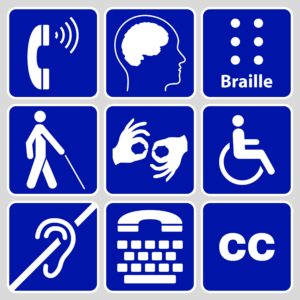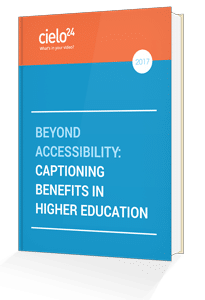The benefits and laws around Closed Captions. Closed captions are the visual display of the audio portion…

10 Reasons Why Closed Captioning for Education Is a Must
10 Reasons Why Captioned Educational Video Is a Must
Not sure why closed captioned educational video is necessary? We’ve got 10 great reasons why you should start captioning for education right away.
1. It’s the Law

The Americans with Disabilities Act and Section 504 of the Rehabilitation Act require captioning on educational video that is available to students as well as the public, to ensure effective communication for people who are deaf and hard of hearing.
Section 504 and Title II of the ADA requires captioned video content for public universities and Title III requires captioned video content for private universities
The Individuals with Disabilities Education Act (IDEA) ensures that students at public K-12 schools have equal access to education, which may include captioned educational video.
2. Captions Clarify Video for All Students
While closed captioning for education is crucial to prevent disability discrimination, there are many additional benefits. The first of which is that captions help all students better understand and focus on educational videos. Captions clarify the dialogue when:
- the speaker has an accent
- technical terms are used
- the audio is muffled or too quiet
- the environment is noisy
All of these issues would normally distract students’ focus, but with captions, students can easily follow along without a problem.
3. Captions Aid ESL and Foreign Language Students
There are 4.5 million public school students in the U.S. whose first language is not English, as well as thousands of international students that come to the United States. Captions are a powerful way to help non-native speakers fully understand key concepts, especially when dealing with technical subjects.
4. Captions Aid Students with Learning Disabilities
Learning disabilities affect thousands of students and when not accommodated, can hinder students’ success in higher education. In 2014, only 17% of young adults with learning disabilities received accommodations and supports in postsecondary education because of their disability. Captions are an easy but impactful way to aid students who have trouble processing speech and auditory components in media.
5. Captions Improve Reading Comprehension & Literacy
Researchers Greg McCall and Carmen Craig found that reading comprehension scores from students increased dramatically when captioned educational video was used compared to uncaptioned educational video.
Another study conducted by Planet Read showed that captioning on TV in India greatly increased the literacy rate of children, doubling the number of functional early-age readers.
6. Captions Improve Retention & Focus
Captions are eye-catching and allow students to read along with the video. This combination of audio and visuals creates the best learning environment for students. The U.S. Dept. of Labor tested research subjects’ recall for information delivered orally, visually, or both orally and visually after a three-day time period.
Oral-only instruction had an information retention rate of 10% and visual-only instruction had a retention rate of 35%. The combination of both visual and oral instruction resulted in a 65% retention rate.
7. Captions Improve Test Scores

Robert Keith Collins, a professor of American Indian studies at San Francisco State University conducted a study on captioned educational video. During the first year of a 2-year case study, Collins showed videos without captions to establish a baseline of student comprehension, then in the second year, he turned on the captions and began to see improvement in comprehension and grades.
His students went from receiving C’s, D’s and F’s in the non-captioned year, to A’s, B’s and C’s in the captioned year. Students noted that video captions helped them focus and take better notes.
8. Captions Enable Search Across Video Platforms
Schools can use their video platforms as a powerful library. When videos are not captioned, you have to scroll through the entire database to find what you are looking for. When you use a captioning service to create captions and transcripts, the textual data opens your videos up to a full video library search. Rather than scrolling through endless videos, you now can search for keywords, concepts, speakers and more within seconds and all relevant videos will appear.
9. Captions Create New Study Aids
Caption data provides two stellar ways for your students to study and further interact with your video lectures.
First, some video environments allow you to search for keywords, concepts, speakers and more while the video is playing. This allows students to directly jump to concepts and terms they need help with, without watching the entire video repeatedly.
Additionally, captions come with a transcript. When an educator includes a video transcript along with an educational video, students are able to read along the with video, print the transcript, and take notes directly next to the relevant content.
10. Captions Boost Recruitment Efforts
Captioning for education isn’t just about helping students. Universities can take advantage of captioned video to improve their recruitment efforts without breaking the bank. Admissions officers can’t visit every high school and students can’t visit every potential college. But most students have online access where they can watch campus tours, view sample lectures, access admissions resources, and even upload interview recordings without the expense of visiting.
Video expands access to the students, schools, and regions for whom your school was never even on the horizon. Captioning these videos ensures that you reach every potential student in a welcoming way, regardless of whether they have a hearing disability, speak English as their native language, or are on the go.
Closed Captioning for Education Is Easy
All you have to do is enlist a third-party professional captioning service. You’ll want to make sure they provide 99% accurate captions or else you will be in violation of the ADA and Section 504. Check out our guide to choosing the right captioning service here.



